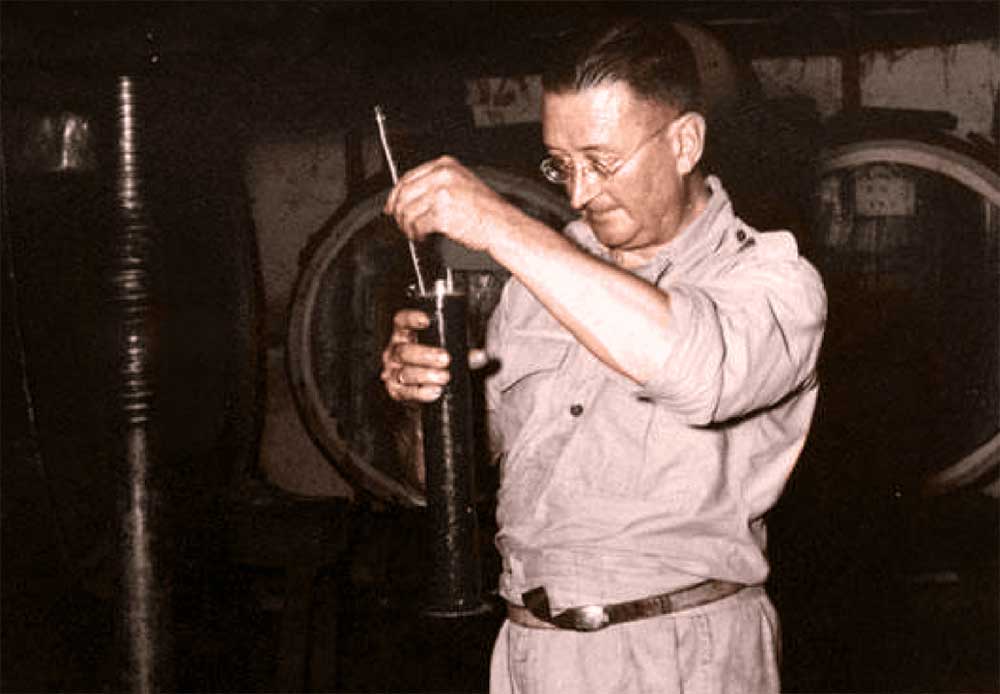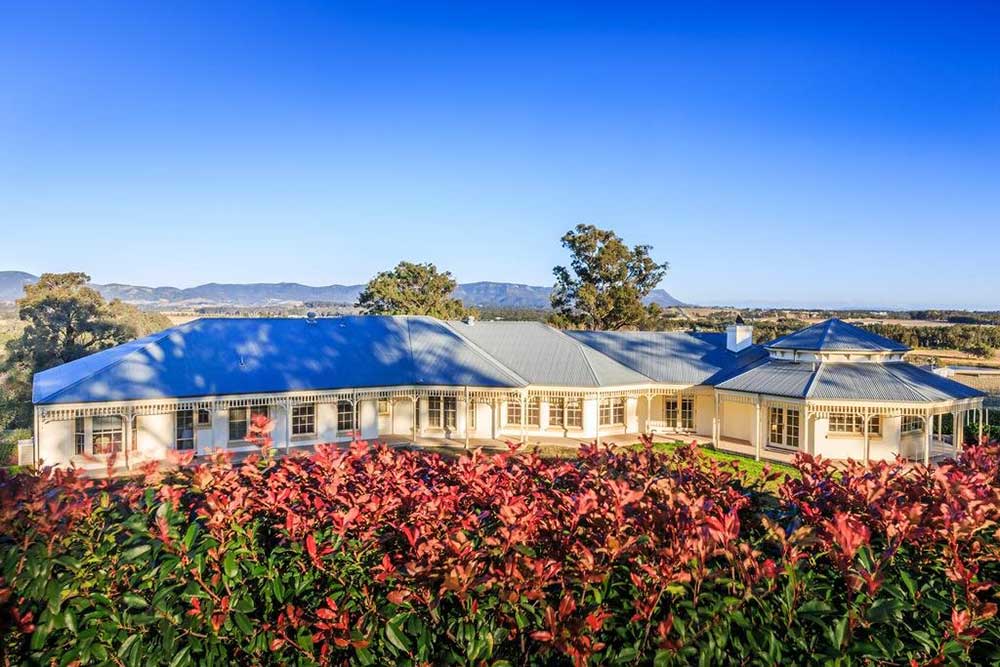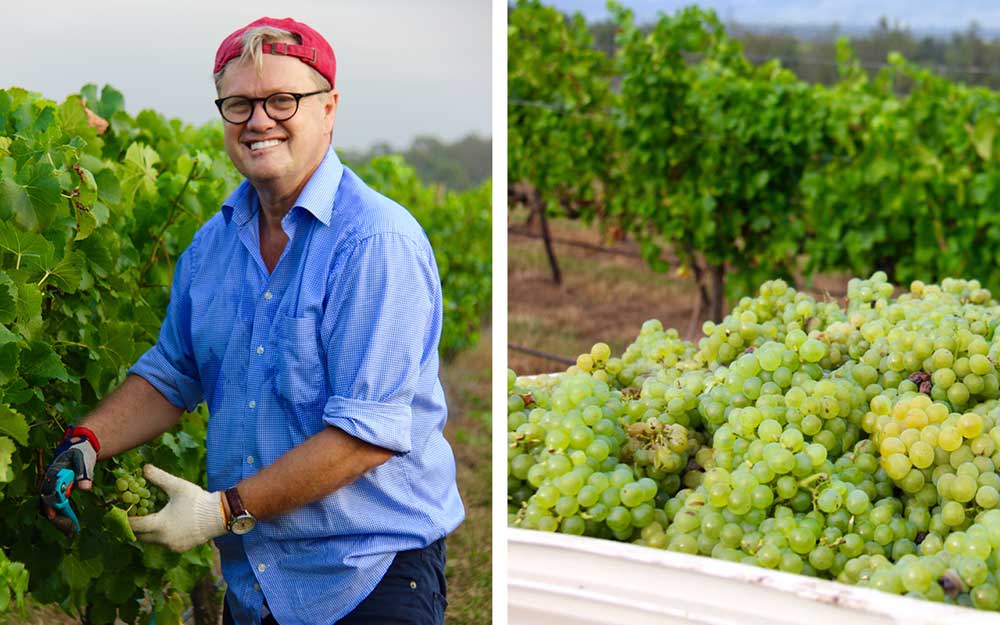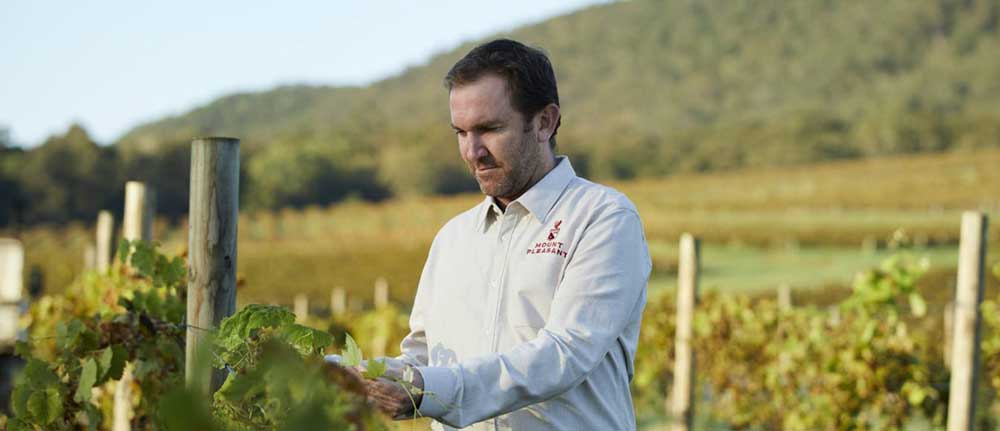I’ve just finished reading The Wine Hunter, by Campbell Mattinson - a great read, telling the story of Maurice O’Shea, the legendary winemaker who crafted some of Australia’s greatest wines.
The book gives a great insight not only into the genius of O’Shea, but also the Hunter Valley in general. I came away with renewed respect for Hunter winemakers and the difficult conditions under which they make some top wines, many of which I feel are greatly under appreciated.
 Hunter Valley legend Maurice O'Shea.
Hunter Valley legend Maurice O'Shea.
The book traces a history of back-breaking boom and bust, with plantings ballooning from 20 acres in 1835, to 500 by 1850, reaching nearly 6,000 by 1866, followed by a decline to 2,700 in 1922 and slashed to a mere 1,100 acres by 1947. Wow, what a bubble.
For all the optimism during this time, the harsh reality of the almost semitropical Hunter environment was not only rain, heat, humidity and grape disease posing a constant threat, but the possibility of drought, fires, frost, hail, or any combination of these. All this, while in tin sheds with dirt floors and no electricity, was a continuous struggle, carried out in a remoteness and isolation we would find hard to conceive of today.
O’Shea noted that in the Hunter, grapes mature in summer, instead of the more usual autumn, resulting in a lower sugar content at ripening, which in turn means lower final alcohol. He realised that elevated, sloping sites, with rich red volcanic soil, were good for shiraz and believed that the “lower lands of the valley, on the sandy soils, on the old seabeds, that Chablis-style wines could be made, and made well, preferably with the semillon grape.” (The Wine Hunter, page 61.) These important observations are responsible for the unique style of wine the Hunter makes, ones with lower alcohol and finesse. Ones that I like.
While O’Shea correctly identified the suitability of shiraz and semillon, he also planted many other varieties, most notably pinot noir (1921) and montils, as well as several others still to be identified. And like a century ago, there are others now in the Hunter trying new varieties to suit its unique conditions, including one I came across recently.
Brycefield Estate
The beautiful Brycefield Estate was originally planted in the Lovedale area in the late 1990s by local businessman Allan Keller, before being acquired by an investor in 2008. While the impressive tree-lined driveway, beautiful house and surrounding gardens were all well maintained, by the time the property came onto the market again in 2017, the 18-acre vineyard was sadly neglected.
 In its prime, it had produced prize-winning chardonnay, semillon and verdelho, under its own label, as well as providing fruit to Brokenwood for their successful semillons. But the vineyard was now a mess, overgrown with grass, while grapes withered on unpruned vines, lying tangled on broken posts and wires.
In its prime, it had produced prize-winning chardonnay, semillon and verdelho, under its own label, as well as providing fruit to Brokenwood for their successful semillons. But the vineyard was now a mess, overgrown with grass, while grapes withered on unpruned vines, lying tangled on broken posts and wires.
Newcastle orthopaedic surgeon Bruce Caldwell, had coveted the property for years. Bruce grew up on the shores of Lake Macquarie, the son of wine and food loving, professional parents, not far from the Hunter. His father had a love of the Hunter and his pharmacist mother an interest in science and chemistry - a serious passion for wine seemed inevitable. After medical school, Bruce did a year of viticulture at Charles Sturt University as an external student. But juggling the course and studying to enter surgery was too much, so he stuck with medicine. In 2017 the time was finally right, so he and partner Deborah Humble, (who also happens to be Australia’s leading mezzo-soprano), snapped up Brycefield, and the dynamic duo set about restoring the vineyard… properly.
The insignia for Brycefield Estate is a combination of the Medical Caduceus and the Winged helmet of Wagner’s Brünnhilde, reflecting Bruce being a doctor and Debrah an opera singer.
 They engaged local viticulturalist Liz Riley, who in 2021, was awarded the prestigious 2020 Graham Gregory Award, recognising her over-30-year contribution to the NSW wine industry. Liz was the first woman to win the award. She received the Award for Excellence from Hunter Valley Wine and Tourism, following her response to the bushfire challenges of 2020. And in 2017 Liz was named Australian Society of Viticulture and Oenology (ASVO) Viticulturist of the Year. She is also married to Jerome Scarborough, winemaker at Scarborough.
They engaged local viticulturalist Liz Riley, who in 2021, was awarded the prestigious 2020 Graham Gregory Award, recognising her over-30-year contribution to the NSW wine industry. Liz was the first woman to win the award. She received the Award for Excellence from Hunter Valley Wine and Tourism, following her response to the bushfire challenges of 2020. And in 2017 Liz was named Australian Society of Viticulture and Oenology (ASVO) Viticulturist of the Year. She is also married to Jerome Scarborough, winemaker at Scarborough.
With Liz on board, the next few months saw their team clean up the vineyards. Rows were mown, vines were pruned, posts were straightened, and wires were strung. The semillon was resurrected and is now made under Brycefield’s own label by top Hunter winemaker Andrew (Thommo) Thomas, with any excess fruit eagerly sought by both Thommo and Brokenwood. The chardonnay was replanted with a new clone and the dead 3-acre verdelho block was ripped out entirely. The question then - what to do with the empty paddock?
As Bruce tells the story, he was standing in the vineyard with viticulturalist Liz on a 38-degree day discussing the possibility of planting a heat tolerant and disease resistant Italian variety. Vermentino was considered, before Liz suggested a variety that was just being released… pecorino.
If you’re like me, you think of cheese when you hear pecorino, but it’s also a grape variety native to central Italy, most notably Marche and Abruzzo. Ian D’Agata’s terrific book Native Wine Grapes of Italy has quite a spiel on the variety, suggesting the variety’s name came from “sheepherders who ate the grapes while accompanying their flocks up and down the valley in search of food.” D’Agata also notes that “pecorino is not just a great grape variety, it is also one of Italy’s biggest wine success stories of the twenty-first century.”
This ancient variety went from being virtually extinct to being a fixture on Italian wine lists, surging from 70ha to 2,500 ha in the first 15 years of this century. The incredible resurgence was due to two men, Guido Cocci Grifoni of the Cocci Grifoni estate in Marche and Luigi Cataldi Madonna of the Cataldi Madonna estate in Abruzzo.
 Bruce Caldwell picking pecorino.
Bruce Caldwell picking pecorino.
The reason for the popularity? Everyone loved the wine! Fresh, aromatic and acid-driven, the Oxford Companion to Wine says it’s “made a varietal comeback because of its firm, dry, minerally white wine”. D’Agata provides a little more detail: “in general pecorino wines are usually delicate herbal (sage, thyme, mint), with balsamic nuances to the crisp apple and pear aromas and flavours”. I like the crisp citrus/lemon line you find in Australian expressions.
Back at Brycefield, Bruce had a love of pecorino from his trips to Italy and some quick research suggested it could be ideal for the site. Aside from producing delicious wine, as Jancis Robinson’s tome Wine Grapes notes, pecorino is early ripening, with good resistance to powdery and downy mildews. Perfect for the Hunter! And so, the first commercial plantings of Pecorino in Australia were planted at Brycefield in 2018.
I caught up with Bruce late last year and he described how the vines have gone on to fulfil their promise - easy to grow, resistant to fungi, bountiful and easy to harvest. The bunches are robust and hang low out of the canopy, so they’re well aerated and resistant to disease, but a little prone to sunburn.
Bruce engaged winemaker Suzanne Little, of the Little Wine Company to make the pecorino. Suzanne completed a degree in wine science at Charles Sturt Uni, and after several winemaking positions in the industry, ended up as senior winemaker at Rosemount. I was also surprised to read that back in the late 80s she spent time as a trainee bonds dealer and completed a degree in economics at ANU. More recently she completed a law degree - as you do when you’re a busy winemaker. Suzanne is something of an alternative varietal specialist, with experience with albarino, barbera, tempranillo, sangiovese, vermentino and most recently… pecorino.
At the 2023 Australian Alternative Varieties Wine Show, Suzanne’s expertise shone through. In Class 5: Pecorino; the top-rated wine was none other than Brycefield’s Il Dottore Pecorino 2022.
 Brycefield’s Il Dottore Pecorino 2022
Brycefield’s Il Dottore Pecorino 2022
Bruce told me the year 2021, leading to the 2022 harvest, was extremely wet. The vineyard was sodden, but the pecorino didn’t seem to mind and while many lost their crops to mildew, the pecorino sailed through.
The wine was fermented in stainless steel to capture freshness. The finished wine is 12.5% alcohol and sealed with a screwcap.
Il Dottore (The Doctor) is a green tinged gold in the glass. On the nose, beeswax and baked pineapple meld with honeysuckle notes. On the palate, butterscotch complements grapefruit rind pithiness, and zingy sherbet. This has a nice viscosity in the mouth and is richer and more weighty than a young Hunter semillon or Aussie riesling. That, combined with firm, clean and refreshing acidity, makes this eminently and imminently drinkable.
“Lime leaf, jasmine, lemon zest. Nice concentration on the palate. Good power and texture, lemon balm, preserved lemon, cinnamon... A structured finish of length and vibrancy.”
“Fresh fruit salad, complex and bright, lots of flavour hidden, deliciously flavoursome.” Judges comments. 92 points, Silver Medal and Top Rated Pecorino, Australian Alternative Varieties Wine Show 2023.
Bruce is now successfully juggling orthopaedics and oenology.
I can offer it for $30 a bottle.
And for those of you hankering for some of the Hunter’s classic semillon and shiraz, here are one of each from two of the region’s top producers.
On a trip to the Hunter a while ago I visited the terrific De Iuliis Wines (pronounced de yooly-iss). Joss De Iuliis migrated as a child from Italy in 1960 and built a successful engineering business in the Hunter, which he sold in 2003. But the winemaking traditions and vineyards his family had owned for generations in the Abruzzi region of Central Italy were still on his mind. In 1988 Joss and wife Anna bought a property in the Lovedale Road region, in the heart of Pokolbin. About 40 acres of vines were planted in 1990, with most of the fruit being sold to Tyrrell’s.
Joss and Anna’s son Michael completed postgraduate studies in oenology at Roseworthy Campus, Adelaide University in 1999. He went on to be a Len Evans Tutorial Scholar (2004) as well as a finalist in the Young Winemaker of the Year Awards (The Wine Society, 2005). He was also one of 8 Nominees for the 2013 Gourmet Traveller Winemaker of the Year. As James Halliday said of Mike “He has lifted the quality of the wines into the highest echelon.”
The family built a state-of-the-art winery in 2001 and continued to plant new vineyards and acquire established ones. These days the family has about 80 acres of their own vineyards and source additional fruit from a handful of carefully selected growers. They handle about 150 tonnes of grapes, making them a small to medium sized winery by Hunter standards.
De Iuliis is considered one of the Hunter’s top producers, with James Halliday’s Australian Companion rating the winery 5 Stars every year since 2010. Mike was awarded 2015 Hunter Valley Winemaker of the Year and 2016 Hunter Valley Cellar Door of the Year.
Year in year out, the entry level Estate wine is one of the Hunter’s best value semillons.
.jpg) Winemaker Mike De Iuliis, second from right.
Winemaker Mike De Iuliis, second from right.
“Pale lime green in appearance with a bouquet of intense lemon and lime characters.
This wine in its youth displays fresh Meyer lemon characters, a light palate, and crisp line of refreshing acidity.”Winemaker’s notes.
“The quality of this super-expressive lemon, apple and lanolin fruit had its life to live, and transformed itself from chrysalis to resplendent butterfly. Date: Nov 2023; Alcohol: 11%; Drink by: 2043.” 95 Points & Top 100 Wines for 2023, James Halliday Wine Companion.
I can offer it for $20 a bottle.
Mount Pleasant
I can’t really write about Maurice O’Shea without offering a wine from Mount Pleasant, one of the Hunter’s most iconic estates, and this is one of my favourites.
The Old Hill Vineyard was planted by Charles King in 1880 and it was this vineyard, along with two adjoining parcels, that O’Shea purchased in 1921, naming the property Mount Pleasant. Since O’Shea’s death in 1956, there have only been 4 winemakers here, with the super-talented Adrian Sparks at the helm since 2018. Sparks was named Hunter Valley Winemaker of the Year at the Hunter Valley Wine Industry Awards in 2019.
 Mount Pleasant winemaker, Adrian Sparks.
Mount Pleasant winemaker, Adrian Sparks.
In a sad episode in the Australian wine industry, McWilliams Wines, long term owner of Mount Pleasant, went into voluntary administration in January 2020. Mount Pleasant was purchased out of administration in 2021 by the Medich family for $14M, who then spent around the same again sprucing up the cellar door and winery.
It seems like it’s onwards and upwards with Mount Pleasant being Awarded Number 3 in the Top 100 Australian Wineries by James Halliday for 2023.
I love the medium-bodied style of shiraz that the Hunter produces, and this is as fine an example as you’ll find.
 Mt Pleasant 1880 Old Hill Vineyard Shiraz 2021
Mt Pleasant 1880 Old Hill Vineyard Shiraz 2021
The fruit was handpicked in three passes through the vineyard, with only the perfect bunches picked on each pass. The fruit was destemmed and transferred to small open fermenters for a brief cold soak to enhance colour intensity. Fermentation was carried out at 18-25 degrees (ie. cool), after which the grapes/wine were gently pressed and aged in large format French oak barrels (approx. 20% new) for almost 12 months, before blending and bottling. The finished wine is 13.5% and sealed with screwcap.
“Aromas of fresh earth and leather are matched by red berry and plum fruits, all replayed on the medium-bodied palate. It’s the overall juicy freshness and elegance that define this wine and its terroir.” 98 points, James Halliday, July 2023, and a Special Value Rating to boot.
“From 141-year-old vines. So clean, such a pure expression of Hunter Shiraz. Boysenberry, raspberry, perfume of aniseed and roses, a discreet sweet soil earthiness. It’s medium-bodied, gentle but tightly packed tannin, fresh feel, expressive and bursting with just-ripe berry flavour, and a super long finish that shows some iron and subtly earthy, and classic, Hunter red fruit. Wonderful. So very good. What a superb wine! Tasted: June 2022; Drink: 2025-2042.” 97 Points, Gary Walsh, The Wine Front.
“Medium-deep red-purple, bright and glowing, with bright aromas of red to darker cherry laced with dried herb and fresh earthy traces. In the mouth, it’s soft textured and medium-full bodied, and the silky-smooth tannins caressing the mouth. Lovely balance and harmony here.” 96 points, Huon Hooke (a great score from him).
Each bottle comes in a wooden presentation box and with a copy of Campbell Mattinson’s book, The Wine Hunter, RRP $45.
I can offer it for $150 a bottle, includes box and book The Wine Hunter by Campbell Mattinson (only 6 bottles available).